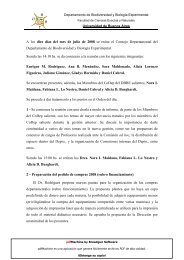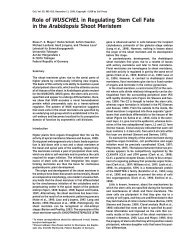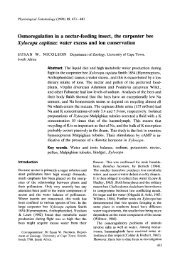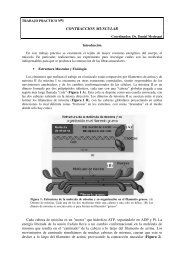The Aerobiology Pathway
The Aerobiology Pathway
The Aerobiology Pathway
You also want an ePaper? Increase the reach of your titles
YUMPU automatically turns print PDFs into web optimized ePapers that Google loves.
opposing gravity. Many fungal spores and pollen can be approximated to spheres in<br />
shape, but some are elliptical, elongated into thin rods or fibres, or even take more complex<br />
shapes e.g. spiral, club-shaped or with radiating ‘arms’. Others may be released in<br />
chains (e.g. Cladosporium spp. or Blumeria graminis) or clumps (e.g. ascospores of<br />
Pyranopeziza brassicae often occur in groups of four, or the rust fungus Puccinia striiformis<br />
may clump in humid weather into groups of seven or more spores). In order to estimate<br />
the terminal velocity and therefore the dispersal characteristics of such particles,<br />
their size and shape can be considered in terms of aerodynamic diameter, i.e. the size of<br />
a spherical object (with, for most spores and pollen, the same density as water) that<br />
would have the same terminal velocity in air. In air at 20ºC, the aerodynamic diameter<br />
d (in μm) for a spore of terminal velocity v t is:<br />
d = 18.02v t<br />
when v t is measured in cm s -1 . <strong>The</strong> aerodynamic diameter also affects efficiency of<br />
impaction.<br />
Shape factors have been estimated for simple shapes such as ellipsoids and rods (Mercer<br />
1973; Chamberlain, 1975) and can be used to estimate the terminal velocity of a non<br />
spherical spore, by dividing the terminal velocity of a spherical spore of the same volume<br />
by the shape factor (McCartney et. al., 1993).<br />
4. Deposition – sedimentation and impaction<br />
Particles in the air descend due to gravity, eventually recrossing the laminar boundary<br />
layer and coming to rest in the still air on a solid or liquid surface (Gregory, 1973). This<br />
can be by sedimentation (passively settling onto a surface), or by impaction (the sticking<br />
of airborne particles onto a surface following an active collision) on an object’s surface,<br />
e.g. a leaf or stigma of a flower because the particle’s momentum may be too great to<br />
allow it to change direction and flow with much lighter air molecules around the object<br />
(McCartney and Aylor, 1987). Sedimentation can be used for trapping air particles<br />
using passive traps. Impaction is the basic principle behind many air-sampling devices<br />
such as the Andersen sampler, Hirst or Burkard spore traps, whirling arm traps (rotating<br />
arm traps or rotorods), air-filtering systems and even sticky rods. A special form of<br />
impaction, can be considered as that in which spores in the air can be removed by the<br />
action of rain. In this case, the particles impact the surface of falling rain drops, to be<br />
deposited within or on the surface of water films, depending on the particle’s hydrophobicity.<br />
5. Impact<br />
Air-borne particles can have many effects including plant, animal and human diseases,<br />
allergies, plant pollination and colonisation of new habitats. To have an effect, particles<br />
THE AEROBIOLOGY PATHWAY 21


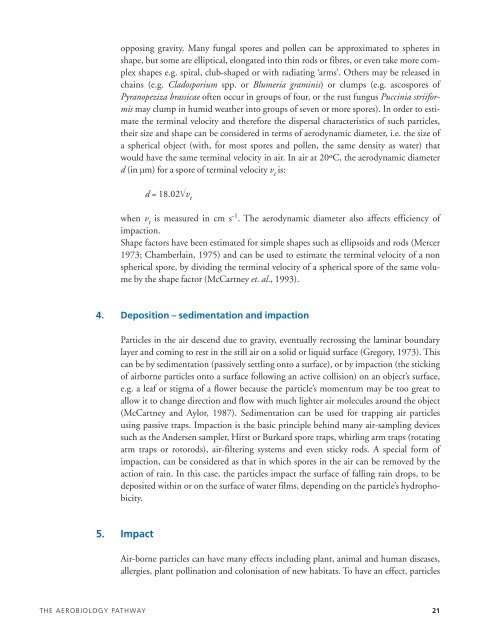

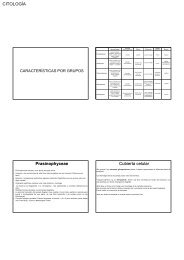


![Estructuras secretoras internas [4.64 MB]](https://img.yumpu.com/14294979/1/190x143/estructuras-secretoras-internas-464-mb.jpg?quality=85)
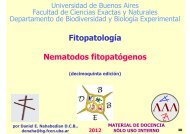
![anatomía y exomorfología [7.14 MB]](https://img.yumpu.com/12744163/1/190x143/anatomia-y-exomorfologia-714-mb.jpg?quality=85)
